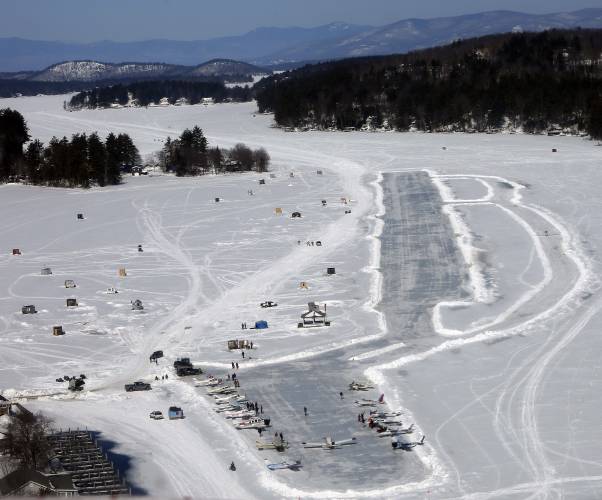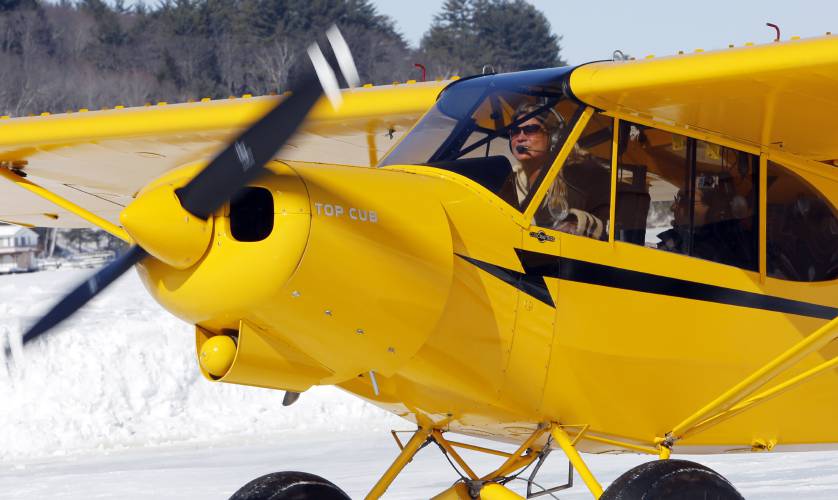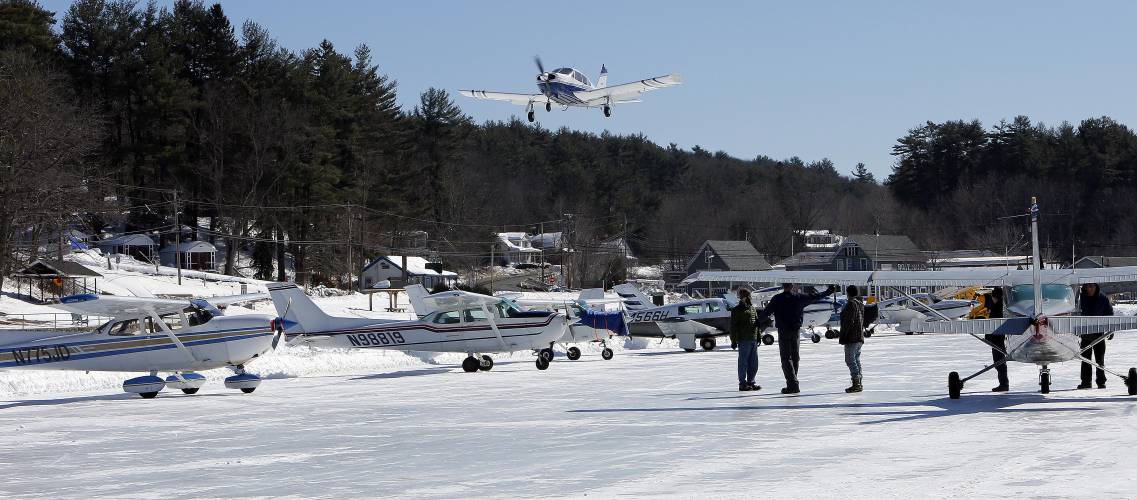Alton Bay seaplane ice runway grounded
| Published: 02-24-2024 2:00 PM |
The ice runway at the Alton Bay Seaplane Base on Lake Winnipesaukee won’t be open this season due to lack of ice. Base officials made the final decision not to open the runway at all the first weekend of February.
The tradition began in 1947 and has been officially operated since 1983, New Hampshire Department of Transportation public information officer Richard Arcand said in an interview.
“It’s a winter runway when there’s enough ice, primarily for smaller single-engine aircraft,” Arcand said. “Mother Nature adds to the challenge. We need a good, cold winter.”
Weather conditions prevented an adequate build-up of thick ice on the bay where airport manager Jason Leavitt and runway manager Paul LaRochelle prepare the novel runway each year.
“To operate the ice runway we need to have twelve inches of ice,” Leavitt said in an interview.
But the bay had only developed about six inches of ice by the beginning of the month, according to Leavitt’s measurements. With the end of winter approaching, that amount is unlikely to substantially increase.
“It’s lighter out for longer, the sun is higher in the sky and it’s stronger,” Leavitt said.
The slow but gradual increase in ambient temperature causes much of the nightly freeze to be lost by the next morning. Even if temperatures did take a dramatic dive, this late into the season it would probably only allow for a day or two of adequate conditions, he said.
Article continues after...
Yesterday's Most Read Articles
 Webster seized and sold his house for back taxes. Now the town has agreed to pay him $38,000
Webster seized and sold his house for back taxes. Now the town has agreed to pay him $38,000
 A Webster property was sold for unpaid taxes in 2021. Now, the former owner wants his money back
A Webster property was sold for unpaid taxes in 2021. Now, the former owner wants his money back
 ‘The rug pulled out from under me’: For certain police and firefighters, last-minute changes to retirement deal breeds distrust
‘The rug pulled out from under me’: For certain police and firefighters, last-minute changes to retirement deal breeds distrust
 Universal EFA program sees 2,000 applications in first week of expansion
Universal EFA program sees 2,000 applications in first week of expansion
 Hillclimbs, nightlife and cruising: Enthusiasts flock to 102nd Laconia Motorcycle Week
Hillclimbs, nightlife and cruising: Enthusiasts flock to 102nd Laconia Motorcycle Week
But such conditions tend to be cyclical, Leavitt said. There is no hard-set date by which the runway must be open, and airport managers anticipate the viability based on environmental factors.
“It has happened in the past,” LaRochelle said. “My first year was a good year. The next year we couldn’t open.”
LaRochelle was formerly the airport manager. He retired after 13 years in 2022.
This is the first time the ice runway has been closed for two consecutive years, LaRochelle said.
Leavitt and LaRochelle look for specific conditions each year which indicate if the ice runway will be viable: cold temperatures in early December; three to five days straight with low or no winds; and an entire week in the early winter where ambient temperatures stay at or below 32 degrees. Heavy snow is generally an indicator of poor ice quality.
“There was a lot of snow in December which is not good,” LaRochelle said. “It’s an insulator — it keeps ice soft.”
A heavy snowstorm in late January dumped around a foot of snow, LaRochelle noted. That storm was followed by moderate temperatures. The combination of those conditions does not allow for a thick sheet of ice to form over the lake.
LaRochelle and Leavitt check the lake each year to gauge the depth of the ice after a layer four inches thick is formed. They walk the bay on foot, starting at the public boat ramp. They drill small holes using a cordless drill, 1.25” wide, every 75 feet and measure the depth at each point with a ruler.
If conditions appear to be conducive to constructing the runway, Leavitt and LaRochelle begin the process by laying out cones which delineate boundaries.
“It’s a safety issue,” LaRochelle said. “I won’t take my truck on the ice unless there is 12 inches of ice minimum across the whole bay. We’re talking about weight,” he said. “Some of our trucks weigh more than these planes.”
Some years the process can be started in December, other years it waits until January. The whole operation is contingent on environmental conditions.
Cancellation isn’t rare. The ice runway was not opened in 2011, 2016, 2020 or in 2023.
“It happens sporadically,” Leavitt noted. “One winter there might not be enough ice, the next year it could be ready super early.”
Flooding early this winter contributed to the lack of adequate conditions, Leavitt said. The flow of the lake is much stronger because of the flood.
“It’s a lot of work to set it up and maintain it for just a couple of days,” he added.
The quality of the ice is another environmental factor Leavitt is monitoring each year. A snowstorm can turn newly-frozen ice into a slush, which isn’t adequate for the runway’s construction.
If the ice is crystal clear and a foot thick, the ice is strong enough to land and launch planes. If the ice maintains a milky appearance, Leavitt knows it likely isn’t.
“It’s cyclical,” Leavitt said. “Pretty typical New England.”
But the ice runway is something of a national rarity. It’s the only one of its kind within the United States outside of Alaska, Leavitt noted.
“The ice runway is kind of a novelty, he said.
The response from the community and from pilots who enjoy using the runway recreationally has been as expected, Leavitt said. People are disappointed because it’s a fun thing to do each year.
But this year’s closure is not necessarily indicative of a long-term trend, LaRochelle stressed.
“It’s going just like it always has, it’s up and down,” he said. “We’re well overdue for an ice-cold winter.”
Aside from the ice conditions, runway administrators are also keeping an eye on the wind and visibility when planning seasonal operations. Planes take off and land in both directions on most runways, Leavitt said. But on Alton Bay, pilots can only take off northwards on Runway 1. If wind conditions run perpendicular to that runway, Leavitt must postpone or cancel flights until conditions change.
Poor wind conditions temporarily grounded planes in 2022.
But previous years have seen much success. Hundreds of planes travel each season to land at Alton Bay, Arcand said. There is room to park 60 at a time and sometimes planes are turned away for lack of space.
In 2019, the runway had the most landings in its recorded history at 783 over a 20-day period, he added. In 2022, the runway hosted about 200 takeoffs and landings.
“It’s the only plowed ice runway in the lower 48,” Arcand said.
Flying into the ice runway is an experience unlike any other, Leavitt said.
He’s a pilot and has been flying into Alton Bay on the ice runway in his Piper Cherokee, a single-engine four-seater airplane, since 2021.
“It’s unique because, typically with most airplanes, you can only go from airport to airport,” Leavitt said.
But the Alton Bay ice runway allows pilots to experience taking off and landing on a surface other than pavement or turf, which comes with a set of challenges all its own.
Pilots taking off and landing on the ice need to be hyper vigilant because the typical traction provided by a runway isn’t there. Pilots can’t rely on their brakes.
Those who typically take off and land on pavement runways need to pay particular attention to details upon takeoff.
Because there isn’t the traction pilots are accustomed to on normal runways, their takeoff on the ice must be patient and methodical. Slowly increasing the power applied to the engine is key in preventing hazardous sliding. Once pilots reach a certain speed, different depending on their aircraft, their tail rudder becomes effective in keeping them on course.
“The really tricky thing is the takeoff,” Leavitt said. “The torque causes the plane to want to rotate to the left.”
If the airplane begins to rotate leftwards too quickly, the pilot won’t have enough traction to correct the course.
Landing is not too different on the ice as it is on any other surface, Leavitt said. The important caveat being the lack of brake utilization. If a pilot comes in too hot, their plane could slide for quite a distance before coming to a full stop.
The runway at Alton Bay needs to be at least 2,600 feet long. Ideally, it’s even longer. The lack of friction and their high operating speeds make landing jet airplanes impossible.
Leavitt’s Piper Cherokee needs to reach speeds of about 65 miles per hour in order to take off from the runway, he said.
But the difficulty varies depending on the texture of the ice. If the ice is rough and hard, it could feel mostly similar to taking off and landing from any other runway.
“Absolutely it’s a lot of fun,” Leavitt said. “You might be a little apprehensive if you haven’t done it before.”
But Leavitt knows another pilot who is anything but apprehensive — he’s been landing and taking off from Alton Bay on the ice runway since the mid-1980s.
Tony Kiley, of Barnstead, is a recreational pilot who began flying into Alton Bay with his father. Now he makes his own runs in a Cessna 170B 4-seater tail-dragger airplane.
Kiley would fly into Alton Bay with his father to eat breakfast at a restaurant located right at the end of the runway, he said.
“Flying in, you have to be at minimum speed,” Kiley said. “You need to land close to the end [of the runway], knowing that you don’t have any brakes.”
They’d also fly up to an unregistered ice runway in Eliot, Maine, to grab breakfast there. But the Alton Bay ice runway is officially registered, meaning insurance companies would honor claims if an accident happens there.
Taking off from Alton Bay, Kiley eases his plane up to speed on the ice over the first 300 to 400 feet before reaching full-power. There’s a two or three-foot berm at the end of the runway, so a pilot needs only a few feet of clearance to take off.
At full power the airplane slowly reaches 20 miles per hour. It’s at that point the rudder on the back of the plane is able to catch enough air to keep the plane straight. Kiley’s Cessna needs to reach about 45 miles per hour to take flight.
“It’s easier to land on the ice than to land on the pavement,” Kiley noted.
That’s because the rough surface of the pavement can cause the plane to bounce around, he said.
But the unique conditions never intimidated him.
“I was flying with my father and he was a very good pilot,” he said. “So I was never nervous — I look forward to it each year. The people running it are fantastic.”
Kiley did remember a particularly hazardous landing wherein he attempted to turn his plane to the right in order to taxi, but strong winds caused the plane to act like a weathervane, turning the direction of the wind.
“It [the wind] blows against the vertical stabilizer,” he said.
He tried making a 270 degree turn to the left but wasn’t able to correct his course and took back off into the air.
“It’s the most fun flying experience,” Kiley said.










 Concord’s two Rite Aid stores shutting soon
Concord’s two Rite Aid stores shutting soon From morning jokes to parental influence: Bow High Class of 2025 graduates
From morning jokes to parental influence: Bow High Class of 2025 graduates
